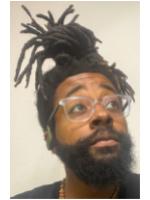

Designing Instruction for Simulation Experiences in the Virtual Classroom: Teacher Educators Perspectives |
Explore and create : Playground
This is presentation 3 of 3, at station "Station 4: Virtual Classroom" within the playground "No Way But Forward: Inclusive Learning in a Pandemic"; scroll down to see more details.
Other presentations in this group:
| Audience: | Coaches, Teacher education/higher ed faculty |
| Skill level: | Beginner |
| Attendee devices: | Devices required |
| Attendee device specification: | Laptop: PC, Chromebook, Mac Tablet: Android, iOS, Windows |
| Topic: | Teacher education |
| Grade level: | PK-5 |
| Subject area: | Math |
| ISTE Standards: | For Educators: Designer
|
The purpose of this presentation is to allow participants to experience Mursion mixed reality simulation technology and use Jamboards to evaluate the inclusivity of the product for use in teacher education spaces.
The presentation will begin with having participants watch a video excerpt from a math methods course, and will use Google Jamboards to track observations of both the software and the preservice teacher learning experience. The presentation will end with a discussion of how to help make these experiences more inclusive for all preservice teachers.
Webel, C., & Conner, K. A. (2017). Using simulated teaching experiences to perturb preservice teachers’ mathematics questioning practices. Mathematics Teacher Educator, 6(1), 9-26.
Landon-Hays, M., Peterson-Ahmad, M. B., & Frazier, A. D. (2020). Learning to teach: How a simulated learning environment can connect theory to practice in general and special education educator preparation programs. Education Sciences, 10, 184-201. https://doi.org/10.3390/educsci10070184
Gundel, E., & Piro, J. S. (2021). Perceptions of self-efficacy in mixed reality simulations. Action in Teacher Education, 1-19. https://doi.org/10.1080/01626620.2020.1864513
Aguilar, J. J., & Telese, J. A. (2020). Perceptions and opinions of the usability of simulations in a mathematics methods course for elementary pre-service teachers. Journal of Education and Practice, 11(12), 9-14. https://doi.org/10.7176/JEP/11-12-02


Fake News? Help Your Students Figure Out the Truth Online
Inspiring Creativity Using Google Apps
UDL in Times of Pandemic, Advocating for a Wayuu Community of Learners